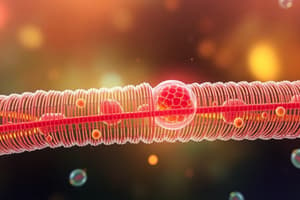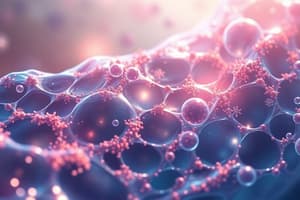Podcast
Questions and Answers
Which of the following statements about a typical plasma membrane is correct?
Which of the following statements about a typical plasma membrane is correct?
- The two sides of the plasma membrane have different lipid and protein composition. (correct)
- The plasma membrane is entirely composed of carbohydrates.
- The two sides of the membrane have the same lipid and protein composition.
- All membrane functions are the same on both sides.
Which of the following best describes the structure of a biological membrane?
Which of the following best describes the structure of a biological membrane?
- Two layers of phospholipids with proteins either crossing the layers or on the surface of the layers. (correct)
- A single layer of phospholipids.
- A rigid protein layer.
- A carbohydrate-based membrane.
The permeability of a biological membrane to a specific polar solute may depend on which of the following?
The permeability of a biological membrane to a specific polar solute may depend on which of the following?
- Temperature.
- The presence of covalent bonds.
- The surface area of the membrane.
- The types of transport proteins in the membrane. (correct)
Which of the following is least likely to be important in holding the components of a biological membrane together?
Which of the following is least likely to be important in holding the components of a biological membrane together?
What makes the structure of the plasma membrane selectively permeable?
What makes the structure of the plasma membrane selectively permeable?
Which of these cannot rapidly pass directly through the phospholipids of the plasma membrane?
Which of these cannot rapidly pass directly through the phospholipids of the plasma membrane?
What is referred to as selective permeability in a plasma membrane?
What is referred to as selective permeability in a plasma membrane?
What will occur to a red blood cell placed in a 3.21% (m/v) NaCl solution?
What will occur to a red blood cell placed in a 3.21% (m/v) NaCl solution?
Which factor does not affect membrane permeability?
Which factor does not affect membrane permeability?
How can a lipid be distinguished from a sugar?
How can a lipid be distinguished from a sugar?
Osmosis is a type of diffusion.
Osmosis is a type of diffusion.
What property of dishwashing liquid makes it useful to wash grease from pans?
What property of dishwashing liquid makes it useful to wash grease from pans?
Which of the following particles could diffuse easily through a cell membrane?
Which of the following particles could diffuse easily through a cell membrane?
The water-soluble portion of a phospholipid is the polar head.
The water-soluble portion of a phospholipid is the polar head.
If a red blood cell bursts in a salt solution, what is the tonicity of the solution?
If a red blood cell bursts in a salt solution, what is the tonicity of the solution?
Which statement about osmosis is correct?
Which statement about osmosis is correct?
In facilitated diffusion, what is the role of the transport protein?
In facilitated diffusion, what is the role of the transport protein?
What cycle does active transport by the sodium-potassium pump follow?
What cycle does active transport by the sodium-potassium pump follow?
Which of the following statements correctly describes the driving forces for diffusion of Na+ and K+ ions?
Which of the following statements correctly describes the driving forces for diffusion of Na+ and K+ ions?
What is the mechanism of glucose uptake in animal cells?
What is the mechanism of glucose uptake in animal cells?
What distinguishes facilitated diffusion from simple diffusion?
What distinguishes facilitated diffusion from simple diffusion?
Which transporter does not use passive transport?
Which transporter does not use passive transport?
Active transport does not require energy.
Active transport does not require energy.
What is the role of transporter proteins in glucose movement across a membrane?
What is the role of transporter proteins in glucose movement across a membrane?
What is typically true about the net movement of an ion across a membrane by passive diffusion?
What is typically true about the net movement of an ion across a membrane by passive diffusion?
During active transport via the sodium-potassium pump, ATP hydrolysis pumps three sodium ions into the cell.
During active transport via the sodium-potassium pump, ATP hydrolysis pumps three sodium ions into the cell.
What type of transport is used to move lactose into the cell when its concentration is higher inside?
What type of transport is used to move lactose into the cell when its concentration is higher inside?
How can the cell increase phosphate concentration in the cytosol when it is lower outside?
How can the cell increase phosphate concentration in the cytosol when it is lower outside?
What is the mechanism of glucose movement against a concentration gradient?
What is the mechanism of glucose movement against a concentration gradient?
How do active and passive transport differ?
How do active and passive transport differ?
What happens during endocytosis?
What happens during endocytosis?
Which movement is due to osmosis when a plant cell is placed in concentrated salt water?
Which movement is due to osmosis when a plant cell is placed in concentrated salt water?
What affects the rate of osmotic movement of water?
What affects the rate of osmotic movement of water?
What occurs when solutions reach osmotic equilibrium?
What occurs when solutions reach osmotic equilibrium?
Flashcards are hidden until you start studying
Study Notes
Plasma Membrane Structure and Composition
- Plasma membranes have distinct lipid and protein compositions on either side, facilitating different functions for the cytoplasmic and exterior surfaces.
- Composed of two layers of phospholipids with proteins embedded or attached to the bilayer, providing structural complexity and functionality.
Membrane Permeability
- Membrane permeability for polar solutes depends on the presence of specific transport proteins, as the lipid bilayer is generally impermeable to polar or charged substances.
- Small nonpolar molecules, e.g., O2 and CO2, can diffuse directly through the bilayer, while ions and larger polar molecules require transport proteins.
- Water molecules can pass through the membrane slowly but efficiently via aquaporins, specialized transport proteins.
Tonicity and Effects on Cells
- Crenation occurs when a red blood cell shrinks in a hypertonic solution (e.g., 3.21% NaCl), while hemolysis is the bursting of a cell in a hypotonic solution (e.g., distilled water).
- Solutions classified as isotonic to red blood cells (e.g., 0.9% NaCl) maintain cell shape.
Mechanisms of Transport
- Simple diffusion is the process by which small, nonpolar molecules pass through the membrane without assistance.
- Facilitated diffusion employs transport proteins to help molecules cross, while active transport requires ATP to move substances against their concentration gradient.
- The sodium-potassium pump is crucial for maintaining Na+ low within cells and K+ high, pumping three Na+ out for every two K+ in.
Energetics of Transport
- Active transport mechanisms use energy (e.g., from ATP hydrolysis) to move substances against their electrochemical gradient, including the cotransport of glucose with sodium ions.
- Osmosis, the diffusion of water, can occur even when solutes cannot cross the membrane, with water moving toward higher solute concentration until equilibrium is reached.
Special Transport Mechanisms
- Endocytosis and exocytosis involve vesicles that transport substances without them crossing the membrane directly.
- Micelles formed by detergents illustrate how amphipathic molecules can encapsulate grease and eliminate it through washing.
Concentration Gradients and Transport
- An electrochemical gradient influences ion movement, with Na+ favoring entry and K+ favoring exit, but inhibited by charge differences.
- The rate of osmotic movement is affected by temperature, pressure, and the concentration gradient of solutes across a selectively permeable membrane.
Osmotic Equilibrium
- At osmotic equilibrium, water molecules remain in dynamic equilibrium, with continuous movement but no net directional flow across the membrane.
Key Transport Proteins
- Specific transporters such as GLUT-1 facilitate glucose diffusion, exemplifying facilitated diffusion, while the sodium-potassium pump exemplifies active transport requiring ATP.
Studying That Suits You
Use AI to generate personalized quizzes and flashcards to suit your learning preferences.




